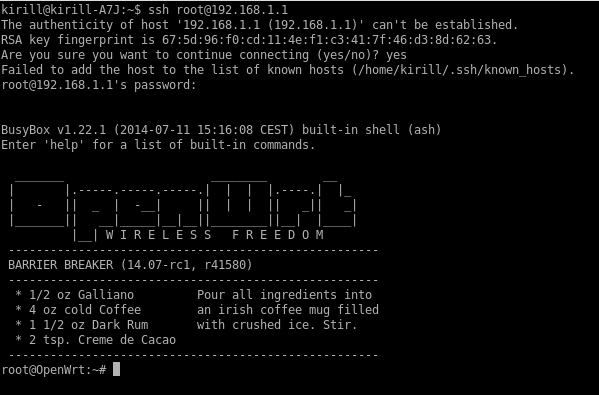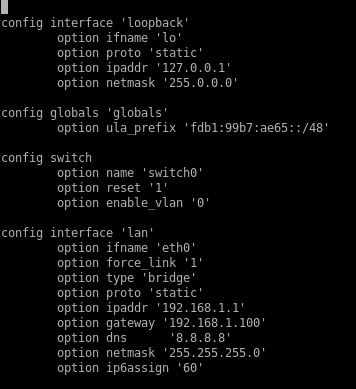We tame the budgetary DCS-930-L IP camera
It was a quiet summer day in the glorious city of Yekaterinburg. If you can assume the weather in this city is really summer. But let's not talk about sad things.
Going through the old junk, I stumbled upon a camera once given to me by a long time ago from a familiar manufacturer.
Once I tried to tame this beast, but my attempts were not crowned with success. For some unknown reason, after the firmware, the trunk could work, but after a reboot everything was lost. The bootloader tried to find the native firmware and, unable to find one, hung in a stupor. Every time to flash the device to work, let's say, too much perversion. So I threw this device into a distant box until better times.
And now, the next free weekend came out to experience the fresh RC Barrier Breaker. And ... it worked out! Not without tricks, but we managed to set everything up and the camera successfully fulfills the task of watching a cat remotely.
')
Interested?
Welcome under the cat for detailed instructions.
Actually, it is worth noting immediately that the company's products have an emergency flashing mechanism, which is also called the Emergency Room. In this wonderful way, you can reflash almost any SOHO router or, as in our case, a camera that is the same router, but more on that later.
In order to enter the emergency flashing mode, you must turn off the power from the router, hold down the Reset and connect the power again. After the display goes off (in our case it is a blue LED), you can release the Reset. Then we go to the factory IP address, not forgetting to reconfigure the adapter of the network card to work in this network itself. For this camera, the factory IP is 192.168.0.20. And when we approach it, the following picture appears to our eyes:

To save your time I will immediately give a link to the image we need.
Give the path to the file and click Upload Firmware NOW.
Everything. Now jam until the device starts to load or until the countdown ends.
The starting address for all openwrt firmware is 192.168.1.1. For this reason, you will need to reconfigure the network adapter again and move to another network.
You can access the flash device through ssh:

After that, using vi, you need to configure Internet access for the device. You can immediately command
It looks like this to me:

Now you can safely run
Well, it does not matter, there is everyone's favorite motion.
Yes, this is the problem of the current RC. There are simply no many packages. What to do?
The solution is really simple, you do not need to collect anything yourself or try to go to the last stable release. You just need to connect another repository. For example, this one .
Again we edit with our favorite
And we get the following result:

Now quite well. You can again update the package list with the
To test it, you can run it with the command
After that, drive into the browser the already familiar address 192.168.1.1 and ...

Thank you for attention.
As noted by the respected aik , this is a very important issue.
And the thing is as follows.
In the standard firmware, among the provided ways to watch videos, there is only a mobile application, a JAVA applet or an ActiveX script.
Personally, it seems to me to use JAVA to watch a video is a slight reengineering, and my N9, for obvious reasons, flies by with this method of viewing.
The basic Android application on it, again, will not run. In this case, the only regular solution would be the mydlink cloud service, but this is not at all desirable. When I realize that the video is being transmitted to the cloud, an easy attack of paranoia overtakes me and I try to get around this decision by the side. What, in fact, was done.
For the most part, of course, this is for entertainment. To summarize: the ability to detect motion was lost, that is, to work in the motion sensor mode, the ability to transmit sound was lost. It is theoretically possible to fix it and I even woke up a sporting interest in this business. So if you would like to see the continuation of the story - write in the comments,subscribe to the channel, put likes, vote, I will be pleased to know that this article was useful to someone =)
UPD: Personally, I and some other people can't fix the device from Chrome. From FireFox, everything is successfully flashed.
UPD2: If you want to offer something interesting for the next part - write in the comments.
UPD3: If someone flies all the settings after a reboot, we execute immediately after the firmware
Thanks for the advice k0ldbl00d .
Going through the old junk, I stumbled upon a camera once given to me by a long time ago from a familiar manufacturer.
Once I tried to tame this beast, but my attempts were not crowned with success. For some unknown reason, after the firmware, the trunk could work, but after a reboot everything was lost. The bootloader tried to find the native firmware and, unable to find one, hung in a stupor. Every time to flash the device to work, let's say, too much perversion. So I threw this device into a distant box until better times.
And now, the next free weekend came out to experience the fresh RC Barrier Breaker. And ... it worked out! Not without tricks, but we managed to set everything up and the camera successfully fulfills the task of watching a cat remotely.
')
Interested?
Welcome under the cat for detailed instructions.
The beginning of time
Actually, it is worth noting immediately that the company's products have an emergency flashing mechanism, which is also called the Emergency Room. In this wonderful way, you can reflash almost any SOHO router or, as in our case, a camera that is the same router, but more on that later.
Firmware
In order to enter the emergency flashing mode, you must turn off the power from the router, hold down the Reset and connect the power again. After the display goes off (in our case it is a blue LED), you can release the Reset. Then we go to the factory IP address, not forgetting to reconfigure the adapter of the network card to work in this network itself. For this camera, the factory IP is 192.168.0.20. And when we approach it, the following picture appears to our eyes:

To save your time I will immediately give a link to the image we need.
Give the path to the file and click Upload Firmware NOW.
Everything. Now jam until the device starts to load or until the countdown ends.
First boot and configure
The starting address for all openwrt firmware is 192.168.1.1. For this reason, you will need to reconfigure the network adapter again and move to another network.
You can access the flash device through ssh:

After that, using vi, you need to configure Internet access for the device. You can immediately command
vi /etc/config/networkIt looks like this to me:

Now you can safely run
opkg update , opkg install mjpg-streamer and ... find that it is not in the repository.Well, it does not matter, there is everyone's favorite motion.
opkg install motion and again there is no such package.Yes, this is the problem of the current RC. There are simply no many packages. What to do?
The solution is really simple, you do not need to collect anything yourself or try to go to the last stable release. You just need to connect another repository. For example, this one .
Again we edit with our favorite
vi /etc/opkg.conf utility vi /etc/opkg.confAnd we get the following result:

Package installation
Now quite well. You can again update the package list with the
opkg update command described above and install mjpg-streamer.To test it, you can run it with the command
mjpg_streamer -i "input_uvc.so -f 15 -r 640x480" -o "output_http.so -w /www/webcam/ -p 80"After that, drive into the browser the already familiar address 192.168.1.1 and ...

Thank you for attention.
PS Why is this all?
As noted by the respected aik , this is a very important issue.
And the thing is as follows.
In the standard firmware, among the provided ways to watch videos, there is only a mobile application, a JAVA applet or an ActiveX script.
Personally, it seems to me to use JAVA to watch a video is a slight reengineering, and my N9, for obvious reasons, flies by with this method of viewing.
The basic Android application on it, again, will not run. In this case, the only regular solution would be the mydlink cloud service, but this is not at all desirable. When I realize that the video is being transmitted to the cloud, an easy attack of paranoia overtakes me and I try to get around this decision by the side. What, in fact, was done.
For the most part, of course, this is for entertainment. To summarize: the ability to detect motion was lost, that is, to work in the motion sensor mode, the ability to transmit sound was lost. It is theoretically possible to fix it and I even woke up a sporting interest in this business. So if you would like to see the continuation of the story - write in the comments,
UPD: Personally, I and some other people can't fix the device from Chrome. From FireFox, everything is successfully flashed.
UPD2: If you want to offer something interesting for the next part - write in the comments.
UPD3: If someone flies all the settings after a reboot, we execute immediately after the firmware
mtd unlock /dev/mtd5 , mtd fixseama /dev/mtd5 and reboot .Thanks for the advice k0ldbl00d .
Source: https://habr.com/ru/post/235193/
All Articles